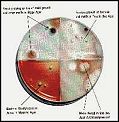What are they?
Biological pollutants include bacteria, viruses, fungi, pollen, dust mites and other insects, animal dander (tiny scales from hair, feathers or skin) and molds and mildew. They can travel through the air and are often invisible. They are usually inhaled, either alone or by attaching themselves to particles of dust and then entering the respiratory system.
What do they do?
Some biological contaminants trigger allergic reactions, including hypersensitivity pneumonitis, allergic rhinitis, and some types of asthma. Infectious diseases, such as influenza, measles, and chicken pox are transmitted through the air. Molds and mildew release disease-causing toxins. Symptoms of health problems caused by biological pollutants include sneezing, watery-eyes, coughing, shortness of breath, dizziness, lethargy, fever, and digestive problems.
What you can do about them.
- Control the humidity. Biological pollutants thrive in damp, warm environments. A relative humidity of 30-50 percent is recommended for homes. If you use a cool mist or ultra sonic humidifier clean it daily and only use distilled water.
- Keep air conditioner filters clean and change them often.
- If possible install exhaust fans that are vented outside in your kitchen and bathrooms. Clothes dryers should also be vented outside.
- Use synthetic bedding and wash it once a week in hot water.
- Buy an air purifier. It removes and destroys biological pollutants, including microorganisms such as Mycobacterium tuberculosis, viruses, molds, fungi, dust mites, and allergens.
